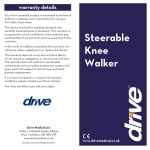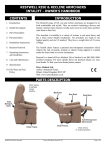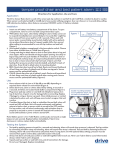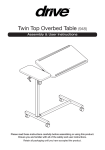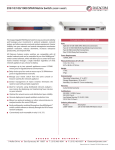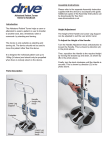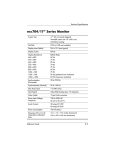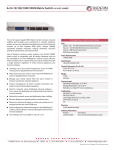Download Trotter User Manual - Special Needs Pushchairs
Transcript
lifetime limited warranty Limited lifetime warranty on frame and cross braces One year limited warranty on other components Your Drive brand product is warranted to be free of defects in materials and workmanship for the lifetime of the original consumer purchaser. trotter® mobility chair TR 1200, TR 1400, TR 1600 & TR 1800 This device was built to exacting standards and carefully inspected prior to shipment. This Lifetime Limited Warranty is an expression of our confidence in the materials and workmanship of our products and our assurance to the consumer of years of dependable service. In the event of a defect covered by this warranty, we will, at our option, repair or replace the device. This warranty does not cover device failure due to owner misuse or negligence, or normal wear and tear. The warranty does not extend to non-durable components, such as rubber accessories, casters, and grips, which are subject to normal wear and need periodic replacement. This warranty does not cover damage resulting from transit use or from exceeding weight limit for user plus items carried. If you have a question about your Drive device or this warranty, please contact an authorized Drive dealer. © 2006 Medical Depot, Inc. All rights reserved. Drive is a trademark of Medical Depot, Inc. Port Washington N.Y. 11050 USA Made in China EU Authorized Representative Drive Medical LTD Ainley’s Industrial Estate Elland, West Yorkshire, United Kingdom HX5 9JP www.drivemedical.com features A 5 B 8 9 1 A. UNFOLDING (Fig 1) 4 figure 1 1. Unhook closure strap. 6 7 2 3 1. Wheel locks 2. Rear Wheels 3. Front Wheels 4. Folding Mechanism 5. Push Handle 6. Bus Transit Tie Downs (optional) 7. Footrest 8. Five-points “H” Harness with Padded Covers & Pelvic Belt 9. Closure Strap 2. Place chair in the upright position, hold one push handle (A) and press firmly on the seat rail (B) on the opposite side. 3. Press down the seat rail until the chair is completely open. 4. Press down the locking brace to its full extended position (Fig. 2). operating instructions: NOTE: A Before seating a child always check that the mobility chair is properly locked in its upright position and that the wheel locks are engaged. figure 2 B. WHEEL LOCKS (Fig 3) D. FOLDING (Fig 3) 1. To engage, pull both wheel lock levers (A) back until the locking bar pushes into the wheel and the lever locks into position. 1. Engage wheel locks (A). Remove the child from the chair. 2. To disengage, lift both wheel lock levers until the locking bar comes free of the tire and the lever locks into position. 2. Trotter® Mobility Chair cannot be folded with head rest extension (B). 3. Swing footrest to the side. 3. Lift locking brace (Fig. 2A) from the center. 4. Lift center of seat slightly. B C 5. Hold one push handle (C) as you pull the opposite seat rail towards you (D). 6. Place chair on its back and press the seat rails to a complete fold. 6. Wrap the closure strap around chair and click to lock. D. TRANSIT OPTIONS Bus Transit Tie Downs are available and should be used with restraint systems that conform to SAE J2249 requirements. D A The trotter has passed a dynamic crash test done with a 130 lb. front facing occupant tested at 30 mph (48 km/h) adjustments: Positioning and growth adjustments should be done in the following order: 1. Seat 2. Back figure 3 C. FOOTREST 1. At the lowest point, footplates should be at least 2” off the ground. 2. Avoid putting weight on the footrest. 3. Never lift the Trotter® Mobility Chair by the footrest. 3. Positioning belt & harness 4. Footrest 5. Head support 6. Additional standard and optional adjustments as required 7. Ensure that all adjustment screws are tight SEAT DEPTH ADJUSTMENT 1. Determine the proper seat depth. 2. To change seat depth, undo the Velcro® that attaches the back panel to the seat panel. (Fig. 4) 3. Relieve fabric tension by partially folding the chair. A 4. Depress spring button on the side of the seat rail (Fig. 5A) and move seat tube to the desired hole (8, 9 or 10) until spring button relocates. See seat depth matrix. figure 4 SEAT AND BACK ANGLE ADJUSTMENT (Fig 5) 5. Repeat operation on other side of seat. To Adjust The Seat Angle: 6. Reattach the seat panel to the back panel. 1. Locate the seat angle adjustment bolt on the seat rail (B). SET-UP MATRIX SEAT DEPTH MATRIX Seat Angle 15o Seat Angle 22o 12” Width 14” Width 16” Width 18” Width Seat Depth (Hole: 8, 9, 10) Seat Depth (Hole: 8, 9, 10) Seat Depth (Hole: 8, 9, 10) Seat Depth (Hole: 8, 9, 10) Back Angle 85o 14.5, 15.5, 16.5 16.0, 17.0, 18.0 16.5, 17.5, 18.5 17.5, 18.5, 19.5 Back Angle 90o 13.5, 14.5 15.5 15.0, 16.0, 17.0 15.5, 15.5, 16.5 16.5, 17.5, 18.5 Back Angle 95o 12.5, 13.5, 14.5 14.0, 15.0, 16.0 14.5, 15.5, 16.5 15.5, 16.5, 17.5 Back Angle 85o 12.5, 13.5, 14.5 14.0, 15.0, 16.0 14.5, 15.5, 16.5 15.5, 16.5, 17.5 Back Angle 90o 11.5, 12.5, 13.5 13.0, 14.0, 15.0 13.5, 14.5, 15.5 15.0, 16.0, 17.0 Back Angle 95o 10.5, 11.5, 12.5 12.0, 13.0, 14.0 13.0, 14.0, 15.0 14.0, 15.0, 16.0 Chair Width 23.0 25.0 27.0 29.0 Back Height 22.2 21.3 23.6 23.4 SEAT AND SEAT-TO-BACK ANGLE Seat Depth Button-Lock Hole Positions: 8 9 10 Back Angle Mouting Holes: 1 2 3 4 5 Front of Wheelchair 3. Secure the nuts tightly. CAUTION– The modification of the seat angle will affect the back angle. See seat depth matrix. To Adjust The Back Angle: 1. To adjust the back angle, relative to the seat, consult the Set-up Matrix. 2. To relocate the back post along the seat rail, loosen and remove bolts (Fig 4A & Fig 5D) from both sides of the seat and align the back posts along the seat rail in the required location. 3. Put bolts back in place and secure the nuts tightly. 6 Rear of Wheelchair 2. Loosen and remove bolts from both sides of the seat and relocate as required in the top (B) or bottom (C) hole. See Set-up Matrix, hole 6 or 7, for proper location. 7 CAUTION – The modification of the back angle will affect the seat depth. Seat Angle Mounting Holes HOLE PATTERN Seat-to-Back Angle 90o Seat & Seat Back Angle Seat 15o (Front) Seat & Seat Back Angle Seat 22o (Front) Seat-to-Back Angle 95o 1 2 3 6 6 6 3 4 5 7 7 7 B D C A figure 5 FIVE POINT “H” HARNESS & PELVIC BELT ADJUSTMENT FOOTREST ADJUSTMENTS 1. Place user in the chair and position child’s hips. To Adjust Or Remove Footrest: 2. Buckle the pelvic positioning belt to the proper position. 1. Pull out the locking pin (Fig. 8A). 3. Connect both straps of the “H” harness to the pelvic positioning belt. 2. Move the footplate extension tube up or down to the desired position. 4. Adjust both shoulder straps using the adjuster (Fig 6A) to get a snug fit. 3. Align the holes of the footrest with the holes of the housing bracket. 5. To adjust the height of the attachment point of the shoulder straps, undo the knob on the back panel, and take the insert out of the grommet (Fig 7). Place the insert at the required position and tighten in place with the knob. 4. Put the locking pin back in place. A A Range Adjustment figure 8 To modify the range of adjustment of the footrest by reversing the housing bracket: 1. Remove footrest. 2. Remove both screws from the housing bracket (Fig 9A). figure 6 3. Relocate the housing facing up or down as desired. 4. Put both screws back in place. A Standard Position (Down) Reversed Position (Up) figure 7 figure 9 To Modify the Range of Adjustment by Inverting the Footrest Extension Tube Depth Adjustment 1. Remove the footrest. 2. Slide the footplate to the desired position. 2. Remove the cap head screw (Fig 10A) from the foot plate support and pull the footplate assembly off the extension tube. 3. Reverse the footrest extension tube orientation (Fig 11). 4. Insert the footplate assembly into to top opening of the housing bracket. 1. Loosen both fasteners on the footplate (Fig. 12A). 3. Tighten both fasteners. A 5. Tighten the cap head screw. figure 12 A CRUTCH STRAP DEPTH ADJUSTMENT 1. Determine the appropriate depth for the user. 2. Remove the belt from the buckle (Fig. 13A). 3. Insert belt into appropriate slot. figure 10 4. Thread the strap back into the buckle. A figure 11 figure 13








